The Kashi Vishwanath temple has been a living embodiment of India's timeless cultural traditions and highest spiritual values. Vishwanath - 'The Supreme Lord of Universe' is the main deity of the temple, it is one of the twelve Jyotirlingas. Hindus believe that those who come and die here attain liberation. The temple, which is believed to be one of the holiest places of worship for Hindus, was razed multiple times but it has been reconstructed every time due to its religious importance and perseverance of Hinduism believers. This article tells the known history and interesting facts about the temple.
History
It’s tough to date its origin period, but the temple is mentioned in the holy Skanda Puranas. As per the available history, the Vishwanath temple was first destroyed by the army of Qutb-ud-din Aibak in 1194 CE. The temple was rebuilt by a Gujarati merchant during the reign of Delhi's Sultan Iltutmish (1211–1266 CE). It was demolished again during the rule of either Hussain Shah Sharqi (1447–1458) or Sikandar Lodhi (1489–1517), and rebuilt by Raja Todar Mal in 1585, interestingly Akbar funded it.
Attack on Temple by Aurangzeb
In 1669 CE, Aurangzeb destroyed the temple and built the Gyanvapi Mosque in its place. The remains of the erstwhile temple can be seen in the foundation, the columns and at the rear part of the mosque. The notable English scholar, orientalist and antiquary, James Prinsep sketch work year 1834 mentions the Gyanvapi mosque as Temple of Vishveshvur( Photo Source: British Library).
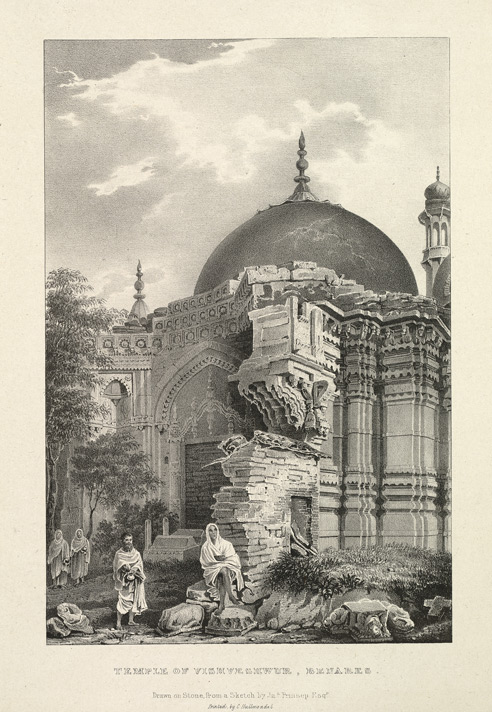
Importance of 
 GyanVapi Well
GyanVapi Well
The GyanVapi well sites to the north of the main temple and during the invasion by the Mughals the Jyotirlinga was hidden in the well to protect it at the time of the invasion. It is said that the main priest of the temple jumped in the well with the Shiv Ling in order to protect the Jyotirlinga from invaders. Many people have faith that the original Shivling is inside the well and thus it has the utmost religious importance. Photo Source: Wikipedia
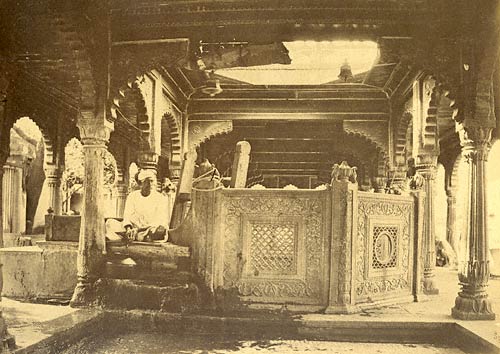
The Nandi Bull Idol
There is huge Nandi idol in the Kashi Vishwanath premises which faces towards the old temple and the existing Gaynvapi mosque. Photo Source: Wikipedia
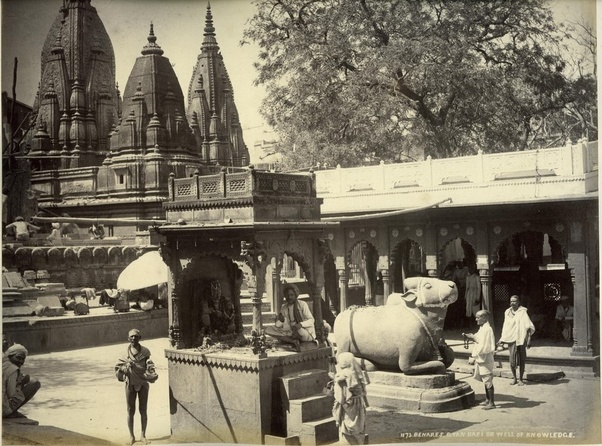
Reconstruction of the existing Temple
The current temple is situated adjacent to the Gyanvapi Mosque. There were multiple attempts made in past to reconstruct the temple on to the same site. In 1742, the Maratha ruler Malhar Rao Holkar made a plan to demolish the mosque and reconstruct Vishweshwar temple at the site. However, his plan did not materialize, partially because of intervention by the Nawab of Awadh, who was given the control of the territory.
Around 1750, the Maharaja of Jaipur commissioned a survey of the land around the site, with the objective of purchasing land to rebuild the Kashi Vishwanath temple. However, his plan to rebuild the temple did not materialize either.
In 1780, Malhar Rao's daughter-in-law Ahilyabai Holkar constructed the present temple adjacent to the mosque. It is said that Lord Shiva came in the dream of Rani Ahilya Bai Holkar which motivated her to construct the temple.
In the photo, the elevation of the existing temple.
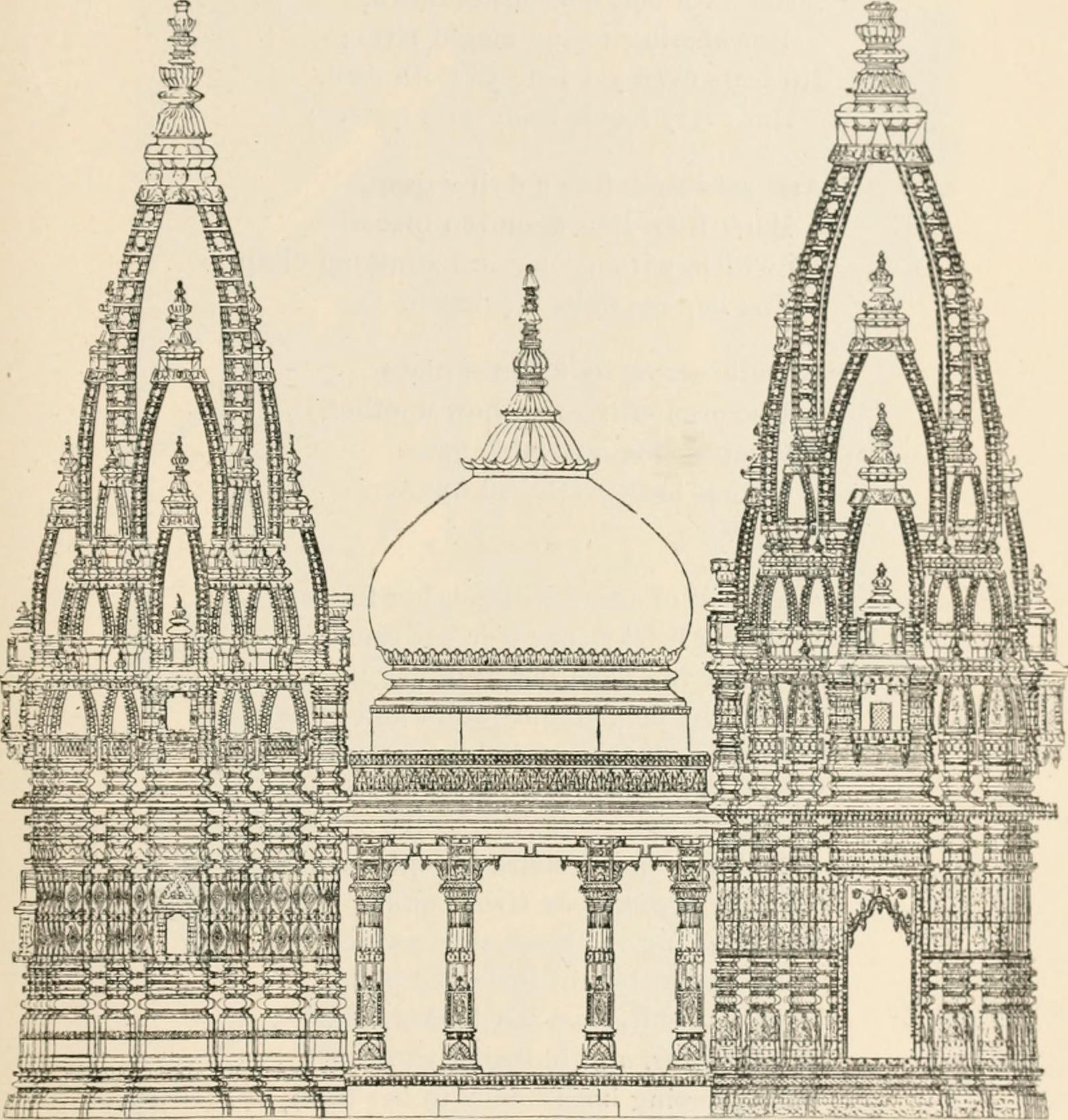
Existing Temple Architecture
Structure of the Mandir is composed of three parts. The first part compromises a spire on the Mandir of Lord Vishwanath or Mahadeva. The second is gold dome and the third is the gold spire atop Lord Vishwanath carrying a flag and a trident.
The dome of the temple is made up of pure gold (probably 1 ton in total) which was donated by Maharaja Ranjit Singh in 1835. There is a lot of silverwork in the inner sanctum and silver coins are studded on the floors too.
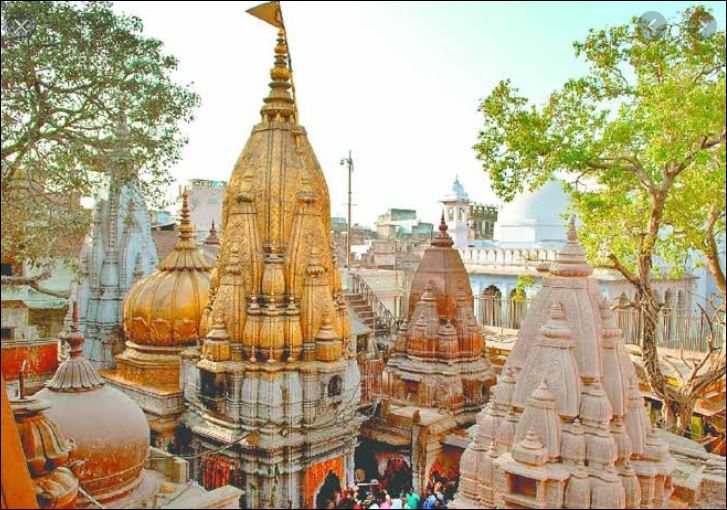
Sri-Yantra in the Sanctum Sanctorum Dome
One of the notable thing in the temple is the dome of the inner sanctum, it is adorned with Sri-Yantra. Due to this, the mandir is considered very suitable for tantra puja siddhi. In the court of Baba Vishwanath, there are four major gates from the point of view of Tantra, which are as follows- 1- Shanti Dwar 2- Kala Dwar 3- Pratishthan Dwar 4- Nivritti Dwar.
The Legend and Significance of the Temple
Kashi Vishwanath Temple is a jyotirlinga. Lord Brahma and Lord Vishnu got into an argument that broke into a fight about their supremacy. As a moderator, Lord Shiva took a form of light that pierced through three worlds. Shiva demanded them to find the tip of the light and the one who finds the tip of the light would be considered supreme. Vishnu took the form of a pig and dug down to find the tip and Lord Brahma rode up to find the tip. The place where Shiva’s light pierced through the earth are the 12 jyotirlingas and this temple is one among those.
Hindus believe that those who come and die here attain liberation. It is said that Lord Shiva gives the Tarak Mantra to the ones who are going to die here. Some also believe that the Lord resides here and is the giver of liberation and happiness. The one who prays and worships Vishweshwar with devotion attains all his desires and one who incessantly recites his name attains all siddhis and finally gets liberated. The Ganga river and shakteepeeth Maneekarneeka are on a walking distance from the Temple.
Temple Darshan and Arti Timing
The Vishwanath temple opens daily at 2.30 A.M. for Mangala Aarti and between 3 to 4 A.M. ticket holders are permitted to join. The timing of general Darshan is from 4 to 11 A.M. The timing for midday Bhog Aarti is from11.30 to 12 A.M. Between 12 noon to 7 P.M., general devotees are free to have Darshan. From 7 to 8.30 P.M. the Sapta Rishi Aarati is held after which Darshan is possible again till 9 P.M. At 9 P.M. the Shringar/Bhog Aarati starts and after that Darshan is possible only from outside. Shayana Aarti starts at 10.30 P.M. and the temple closes at 11 P.M. Devotees can avail tickets for the queueless darshan online.
How to reach Kashi/Varanasi
Varanasi is easily accessible through Road, Train and Airport. The temple is located in the downtown of the city and easily accessible through the public and private mode of transport.
Written By:
Abhishek Pandey